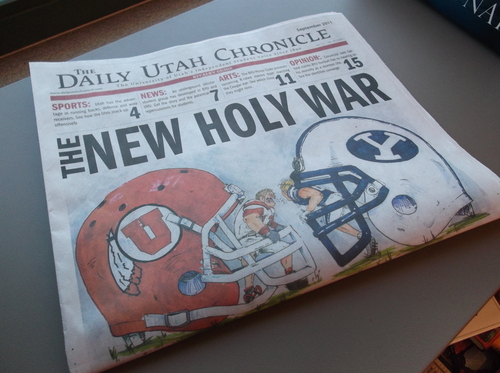This is an archived article that was published on sltrib.com in 2014, and information in the article may be outdated. It is provided only for personal research purposes and may not be reprinted.
The University of Utah's student newspaper may publish a print edition on fewer days and make other changes to cope with a sharp decline in revenue.
The Student Media Council, which oversees The Daily Utah Chronicle, is exploring how to make more money and draw more readers in an age of media upheaval.
"Our circulation has been dropping for years, as has our budget, ever since 2007," said Editor-in-Chief Emily Andrews, who's concerned some of the ideas on the table could "eviscerate" the paper.
"I hope it does not turn into something that will so radically alter [the paper]," she said, "and diminish the educational value for the writers and the reporters and the editors, something that causes The Chronicle to lose the independence we fight really hard to protect."
Something, though, will have to change quickly, said Jake Sorensen, director of student media. Advertising revenue has plunged from $700,000 in 2007 to $370,000 this year and website readership has been stagnant.
"It's really frightening," he said. "I don't think we can go through another fiscal year doing the same thing we've been doing."
He hopes to have a plan spelled out by summer and changes in place by next fall — if not sooner.
On Feb. 21, the Student Media Council, which oversees both The Chronicle and the student Internet radio station, K-UTE, will hold an open meeting modeled after the entrepreneurial TV show "Shark Tank," hoping to gather new ideas.
"If you were going to build a modern media organization on campus, what would it look like?" Sorensen said. "Just pretend we could start from scratch."
Along with more social media promotion and breaking news online, he suggested working with K-UTE to produce multimedia stories, integrating more video elements and promoting big events across platforms.
"The role the Chrony plays in providing a watchdog voice for students has to be maintained," said Sorensen, using the paper's nickname. "What it will look like, I don't know, but it absolutely must be maintained."
Sorensen, a U. employee who started as a student in 2002 and has been in his current position since 2006, also pointed to two iPhone apps launched last year that aggregate the paper's coverage of the football and basketball teams. They've gotten steady, though not yet profitable, engagement.
About 80 students are employed on the newspaper's editorial side and five student salespeople sell ads for both the radio and newspaper. All are paid, ranging from a per-story fee of about $15 to $25 to an $85-a-day wage and $300-a-month living stipend for Andrews, who estimates she spends about 60 hours a week at the paper.
Along with ad revenue, the paper is funded by a $6.18 fee charged to U. students that funds the paper and radio station and makes up about 53 percent of the budget.
Cuts have been made this year to deal with the revenue shortfall, including slicing the number of papers printed by about 20 percent, to 8,000 copies Monday through Thursday and 6,000 on Friday.
Andrews also trimmed editor salaries, as well as budgets for employee morale and travel to away football games. But for her, some of the ideas on the table could be a dangerous departure from the paper's mission, including a cut in print publication from five days a week to three.
"I just think that would be catastrophic," she said, adding it would undermine staff morale as well as the paper's presence and authority — and deepen the drop in print advertising revenue.
Likewise, moving the newspaper to the U.'s Department of Communication to eliminate rent expenses and possibly get more university subsidies could portend less editorial independence and control for students, whose biggest learning experience often comes from doing their own work and making their own mistakes, she said.
"I'm really hoping it won't come to that," Andrews said, though Sorensen contends a move doesn't mean the paper would have to give up its independence.
Eliminating pay for student staffers would make it more difficult for many to get involved. "We have a lot of folks on staff that need to be making some sort of income," she said, "even if it's just $50 a week."
Instead, she suggested pushing more ad sales in the paper as well as in a new Friday magazine and outdoor-centric Wasatch Magazine, and saving by switching to a less-expensive printer.
"With the 'Shark Tank' meeting, I think it's a great idea to bring new ideas and experience from people who don't normally have a voice in this discussion," she said.
The decision on how to go forward will be up to the Student Media Council, which has six students, three faculty members and two people from the media industry, and ultimately must be approved by the U. board of trustees. —
Media future meeting
The Student Media Council will host a "Shark Tank"-style meeting on ideas to reinvent the student newspaper and radio station at 9 a.m. on Feb. 21 in the University of Utah's Languages and Communication building (LNCO) in Room 1100. —
Meeting about news media future
The Student Media Council will host a "Shark Tank"-style meeting on ideas to reinvent the student newspaper and radio station at 9 a.m. on Feb. 21 in the University of Utah's Languages and Communication building (LNCO) in Room 1100.



